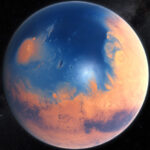Carrying an uncrewed Orion, NASA’s Space Launch System (SLS) — the most powerful rocket in the world — lifted off today at 1:47 a.m. EST from at NASA’s Kennedy Space Center in Florida. Known as Artemis I, the mission is the first integrated flight test of the agency’s deep space exploration systems: the Orion spacecraft, SLS rocket, and ground systems. Orion is planned to travel over 64,000 km (40,000 miles) beyond the Moon and return to Earth over the course of 25.5 days.
“What an incredible sight to see NASA’s Space Launch System rocket and Orion spacecraft launch together for the first time,” said NASA Administrator Bill Nelson.
“This uncrewed flight test will push Orion to the limits in the rigors of deep space, helping us prepare for human exploration on the Moon and, ultimately, Mars.”
After reaching its initial orbit, Orion deployed its solar arrays and engineers began performing checkouts of the spacecraft’s systems.
About 1.5 hours into flight, the SLS rocket’s upper stage engine successfully fired for approximately 18 minutes to give Orion the big push needed to send it out of Earth orbit and toward the Moon.
Orion has separated from its upper stage and is on its outbound coast to the Moon powered by its service module.
“It’s taken a lot to get here, but Orion is now on its way to the Moon. This successful launch means NASA and our partners are on a path to explore farther in space than ever before for the benefit of humanity,” said Dr. Jim Free, deputy associate administrator for NASA’s Exploration Systems Development Mission Directorate.
NASA’s Space Launch System carrying the Orion spacecraft launches on the Artemis I flight test from Launch Complex 39B at NASA’s Kennedy Space Center in Florida at 1:47 a.m. EST on November 16, 2022. Image credit: NASA / Joel Kowsky.
Over the next several hours, a series of 10 small science investigations and technology demonstrations, called CubeSats, will deploy from a ring that connected the upper stage to the spacecraft.
Each CubeSat has its own mission that has the potential to fill gaps in our knowledge of the solar system or demonstrate technologies that may benefit the design of future missions to explore the Moon and beyond.
Orion’s service module will also perform the first of a series of burns to keep Orion on course toward the Moon approximately eight hours after launch.
In the coming days, mission controllers at NASA’s Johnson Space Center will conduct additional checkouts and course corrections as needed.
Orion is expected to fly by the Moon on November 21, 2022, performing a close approach of the lunar surface on its way to a distant retrograde orbit, a highly stable orbit thousands of miles beyond the Moon.
“The SLS rocket delivered the power and performance to send Orion on its way to the Moon,” said Artemis I mission manager Mike Sarafin.
“With the accomplishment of the first major milestone of the mission, Orion will now embark on the next phase to test its systems and prepare for future missions with astronauts.”
“With a successful launch of Artemis I, NASA and the U.S. will reclaim the capability to launch humans to the Moon,” said Professor Bradley Jolliff, a planetary researcher at Washington University in St. Louis and director of the McDonnell Center for the Space Sciences.
“We lost that capability nearly 50 years ago when the last of the Saturn V rockets were retired after the Apollo 17 mission.”
“Artemis I will pave the way for the next generation of astronauts to once again explore a world other than our own.”
“As Earth’s companion in space, the Moon records much about Earth’s early history to help us better understand our past, including events that took place in the early Solar System.”
_____
This article is based on text provided by the National Aeronautics and Space Administration.




